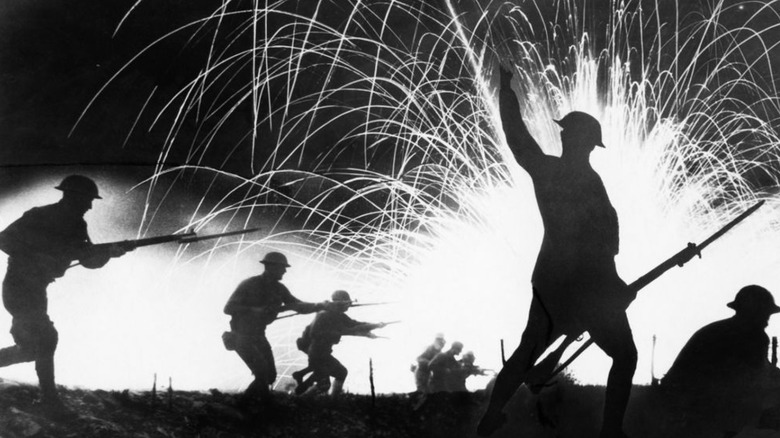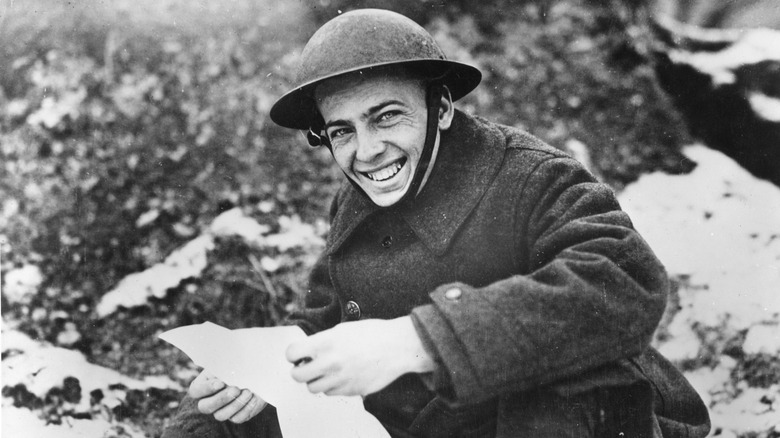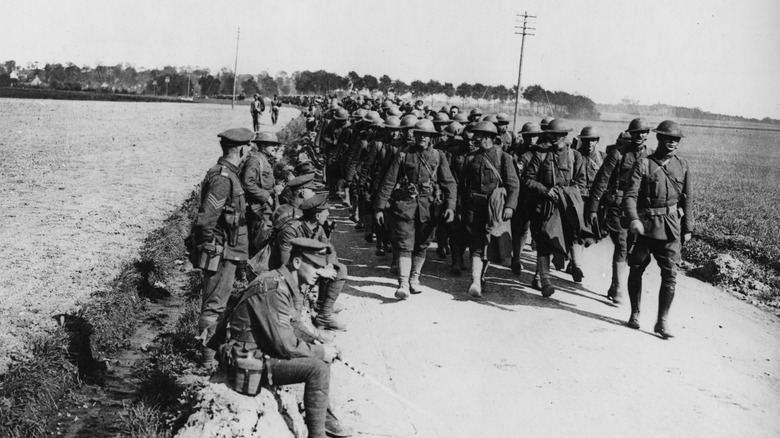Who Were The Doughboys In WWI?
Doughboys: They valiantly wandered the trenches of World War I, trays of pastries in hand, weaving through mud and explosions to distribute soft and gooey, mid-combat pick-me-ups to fatten up all the soldiers for the kill. And so it was that doughboys fed doughy boys, and even under threat of death smiles of sugary delight passed across the faces of the damned. Now in the 21st century their legacy lives on in that little Pillsbury guy with the chef's hat who giggles, "Hoo-Hoo!" The end.
While such musings make for a fun tale, they're sadly untrue. Soldiers in the muddy trenches of World War I had no such saccharine comforts. Per History, World War I trenches were soaked in disease, decay, and filth, and often left soldiers shell-shocked or stricken with "trench-foot:" dead, damp tissue climbing up the leg and which might require amputation. While World War I stretched from the Italian Alps to the Prussian-Russian border, it's the Western Front that's stood out in memory in no small part thanks to books like 1928's "All Quiet on the Western Front."
The United States sent troops to join the Western Front in 1917, just one year before the war ended in 1918. As The National WWI Museum and Memorial says, it was the first time that U.S. troops had acted abroad in defense of foreign nations. And so naturally, American troops needed nicknames like everyone else. "Yanks" was a good option, as was "Sammies." But in the end, "Doughboys" stuck.
Yank, Sammy, Doughboy, and the guys
Just to be clear, it was completely commonplace for World War I soldiers to nickname troops from other countries either out of comradery for allies, contempt for enemies, or just as a simple memory tool. As the British Library says, the British were "Tommy" or "Foot Slogger," the latter being a term used by British infantry to mock cavalry. The Portuguese were "Tony," "Pork and Cheese," or most commonly, "Pork and Beans." Austrians were "Fritz," and Turks "Jacko," "Jacky," "Johnny Turk," or "Abdul." Italians, appropriately so, were "Macaroni," while French soldiers were "Poilu," or "hairy." For their part, the French called themselves "les hommes" or "les bonhommes" — "the men," basically — same as Americans called themselves "guys." This means that "Doughboy" is apparently a term that other nation's soldiers used for American troops, not what American troops called themselves.
But why Doughboys, exactly? Was somebody keen to the effect that future America's processed food would have on the country's population? As History says, no one really knows. One guess states that U.S. soldiers got dusty while trekking here and there like they were covered in adobe brick material. Adobe, as this version of the story goes, transformed into Doughboy. Another clay-based guess says that soldiers kept applying white clay to their uniforms for some reason or another, which when wet contorted the shape of the uniform and made the soldiers look like "doughy blobs."
[Featured image by National Library of Scotland via Wikimedia Commons | Cropped and scaled]
From Adobe to dobie to doughboy
The National WWI Museum and Memorial takes the adobe version of the doughboy story and claims that the adobe nickname stems from U.S. troop involvement in Mexico prior to being dispatched to the European World War I front. Just before doing so, U.S. troops entered Mexico from 1916 to 1917 to try and capture general Pancho Villa of the Mexican Revolution, whom the U.S. considered to be a potential threat to American security, as the U.S. Department of State explains. The American troops failed to capture Pancho Villa, but apparently got very dusty in the meantime. "Adobes" transformed into "dobies," which is a near-homophone for "doughboys." As this version of the tale goes, none of these soldiers' uniforms got washed before being shipped over the Atlantic Ocean, and folks from other countries somehow picked up on the Mexican adobe joke.
Regardless, doughboys remains a funny name for soldiers who ought to be at the height of fitness. And indeed, those soldiers depicted on The National WWI Museum and Memorial website appear quite slim, in shape, and even have immaculately clean uniforms to boot. Uniforms were made from cotton or wool double-breasted jackets that rose to the throat, and pants that hugged at the knees and were tucked into high boots. They carried firearms, wore hats and utility belts, and had a backpack containing toiletries, rations, extra socks and underwear, and a spade for digging trenches. All in all, not very doughy at all.


